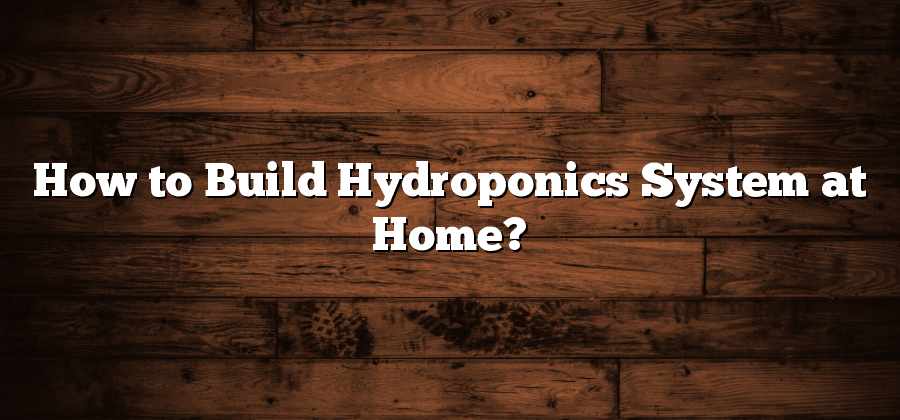Benefits of Hydroponic Gardening
There are numerous benefits to be gained from hydroponic gardening. One of the main advantages is the ability to grow plants in a controlled environment, regardless of the outdoor conditions. With hydroponics, you have the ability to create the perfect growing conditions by adjusting factors like temperature, humidity, and nutrient levels. This allows for optimal plant growth and higher yields compared to traditional soil-based gardening methods.
Another benefit of hydroponic gardening is the efficient use of resources. Since plants are grown in a soil-less system, water and nutrients can be recycled and reused, minimizing waste and reducing overall consumption. Additionally, hydroponic systems require less space compared to traditional gardening, making it a practical solution for urban areas or limited spaces. This not only increases the accessibility of gardening but also promotes sustainable practices by reducing the need for large agricultural land.
Understanding the Basics of Hydroponics
Hydroponics is a modern method of growing plants without the use of soil. Instead, plants are grown in a nutrient-rich water solution that provides them with all the necessary minerals and elements for their growth. This technique has gained popularity due to its numerous advantages over traditional soil-based gardening.
One of the main benefits of hydroponics is that it enables plants to grow faster and produce higher yields. Because plants can directly access the nutrients they need, they can expend less energy on root growth and focus more on developing vibrant foliage and abundant fruits. This allows for a shorter growth cycle, making hydroponics an ideal choice for those who want to enjoy homegrown produce all year round. Additionally, since the system is soilless, there is no risk of soil-borne diseases and pests, further enhancing plant health.
Selecting the Right Hydroponic System for Your Home
When it comes to selecting the right hydroponic system for your home, there are a few key factors to consider. First and foremost, you need to assess your available space. Hydroponic systems come in a variety of sizes, ranging from compact tabletop setups to larger units that can be housed in a dedicated area. It is important to choose a system that fits comfortably within your space while still allowing for adequate plant growth.
Another crucial aspect to consider is the type of plants you wish to grow. Different hydroponic systems are better suited for specific types of plants. For example, if you are interested in growing leafy greens like lettuce or herbs, a nutrient film technique (NFT) system may be ideal. On the other hand, if you have your heart set on growing vine crops like tomatoes or cucumbers, a deep water culture (DWC) system could be a better fit. Understanding the specific needs of your desired plants will help guide you in selecting the most suitable hydroponic system for your home.
Choosing the Ideal Location for Your Hydroponics Setup
When it comes to hydroponics gardening, choosing the ideal location for your setup is crucial for the success of your plants. In order to thrive, hydroponic systems require the right environmental conditions, including proper lighting, temperature, and ventilation. Additionally, considering factors such as space availability, accessibility, and convenience are important in determining the best location for your hydroponics setup.
Firstly, lighting is a pivotal aspect to consider when determining the location of your hydroponics setup. Most plants require sufficient amounts of light to carry out photosynthesis and grow optimally. Therefore, it is essential to place your hydroponics system in an area that offers ample natural light, or invest in artificial lighting fixtures such as LED grow lights. It is important to note that different plants have varying light requirements, so research the specific needs of your chosen plants and ensure your location can accommodate them accordingly.
Another crucial factor to consider is the temperature of the chosen location. For successful hydroponic gardening, maintaining a consistent and appropriate temperature is vital. Most plants perform best within certain temperature ranges, typically between 65 to 80 degrees Fahrenheit (18 to 27 degrees Celsius). Therefore, it is necessary to select a location that can be easily regulated to maintain these optimal temperatures. Factors such as room insulation, access to climate control systems, and proximity to heat sources should be taken into account when deciding on the ideal location for your hydroponics setup.
In summary, selecting the ideal location for your hydroponics setup involves considering various factors such as lighting, temperature, space availability, and convenience. By carefully evaluating these aspects, you can create an environment that provides the best conditions for your plants to thrive and ensure the success of your hydroponic gardening endeavors.
Essential Tools and Equipment for Building a Hydroponics System
To build a successful hydroponics system, you will need a few essential tools and equipment. First and foremost, you will need a reliable grow light. Since hydroponic plants do not receive natural sunlight, a grow light is necessary to provide them with the right amount and spectrum of light for their growth. LED grow lights are the preferred choice by many hydroponic enthusiasts due to their energy efficiency and ability to tailor the light spectrum to the specific needs of the plants.
In addition to a grow light, you will also need a nutrient solution reservoir. This is where you will mix and store the nutrient solution that will be delivered to your plants. You can choose from a range of reservoir sizes depending on the scale of your hydroponic system. It is important to select a reservoir that is made of durable and food-grade material to ensure the safety and health of your plants. Along with these essentials, you will also need pH and EC meters to monitor and adjust the nutrient levels in the solution.






